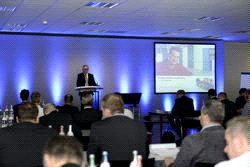Offset Printing
Waterless newspaper printing opens up new avenues

Friday 28. November 2014 - 10th Cortina user workshop at KBA in Würzburg
KBA Cortina users from Germany and abroad met for the tenth user workshop at this waterless newspaper press’ birthplace, Koenig & Bauer, in Würzburg on 12 and 13 November.
KBA Cortina project manager Peter Benz put together an extremely varied agenda for this user group which has proved it is open to new ideas and new paths regarding the application and marketing of high-quality waterless web offset printing. He also hosted the event that focused on providing the latest information on hot topics and the a pooling of news and views between the Cortina users whose numbers have in the meantime increased to 19.
This year’s user meeting began with an evening meal at the Marienberg Fortress, a famous Würzburg landmark. KBA CEO and president Claus Bolza-Schünemann welcomed 75 participants from the newspaper and supply industry to the world’s oldest press manufacturer’s main plant the following morning. KBA marketing director Klaus Schmidt gave an overview of current developments in the print market and the resulting realignment of the KBA Group. His conclusion: “Printed newspapers will still be around in 2030. However, they will be different to today’s newspapers in terms of contents and look. We all have to contribute to promoting the strengths of print in the media arena. Simply reducing costs leads to a downward spiral. Surprising contents, smart commentaries and an attractive appearance are in demand. Good editors and cutting-edge technology are thus essential. Our Cortina users have taken the lead with their creative ideas.”
Head of web press after-sales service Thomas Potzkai then informed the visitors about KBA’s expanded service portfolio for web press printers.
The results of a survey carried out mainly at mid-sized advertising agencies on the image and potential of print in the competitive media arena with a focus on the future of waterless newspaper printing were presented by Matthias Tietz, managing director of Rheinisch-Bergische Druckerei (RBD) in Düsseldorf. Most of the people interviewed were positively surprised by the quality and special haptic qualities of the magazines and supplements printed in waterless coldset as well as newspapers partially coated inline. They also see opportunities to use these more in advertising. Nevertheless, it also became clear that the potential of waterless web offset printing in the agency scene is still considerably less well known than the classic sheetfed and web offset printing processes, or even digital printing.
The materials for waterless web printing, in particular printing plates, inks and blankets, have come a long way since the first KBA Cortina was delivered at the beginning of 2005. For the first users this process which was viewed as exotic ten years ago has become routine. New users such as Trierischer Volksfreund in Germany or Polaris Trykk in Trondheim Norway also profit from the exchange of experiences and from discussions with suppliers at the annual user workshop. Dr Wolfgang Rauh from the Graphic Technology Research Association (Fogra Forschungsgesellschaft Druck e.V.) presented a research project by the German Federation of Industrial Research Associations (AiF) titled “Specification Cortina inks” which aims to contribute to the further standardisation of waterless offset printing. Patrick Zürcher, managing director at Freiburger Druck, a former Cortina pioneer, outlined the results of a focus group which discussed quality management. Valentin Kneile from Rheinpfalz Verlag und Druckerei in Ludwigshafen, Germany, provided representatives of the consumable industry present with an analysis of the current situation from the user’s point of view.
